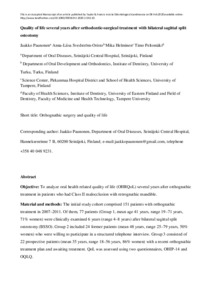Quality of life several years after orthodontic-surgical treatment with bilateral sagittal split osteotomy
Paunonen Jaakko; Svedström-Oristo Anna-Liisa; Helminen Mika; Peltomäki Timo
https://urn.fi/URN:NBN:fi-fe2021042827148
Tiivistelmä
Objective: To analyse oral health related quality of life (OHRQoL) several years after orthognathic treatment in patients who had Class II malocclusion with retrognathic mandible.
Material and methods: The initial study cohort comprised 151 patients with orthognathic treatment in 2007-2011. Of them, 77 patients (Group 1, mean age 41 years, range 19-71 years, 71% women) were clinically examined 6 years (range 4-8 years) after bilateral sagittal split osteotomy (BSSO). Group 2 included 24 former patients (mean 48 years, range 25-79 years, 50% women) who were willing to participate in a structured telephone interview. Group 3 consisted of 22 prospective patients (mean 35 years, range 18-56 years, 86% women) with a recent orthognathic treatment plan and awaiting treatment. QoL was assessed using two questionnaires, OHIP-14 and OQLQ.
Results: Based on responses, patients who had received orthognathic treatment (Groups 1 and 2) had better QoL than those awaiting treatment (Group 3).
Conclusion: Conventional orthognathic treatment, including mandibular advancement with BSSO, seems to have a positive long-term effect on patients' QoL. More long-term follow-up studies are needed to assess the real impact of treatment on patients' lives in the long run.
Kokoelmat
- Rinnakkaistallenteet [27094]
